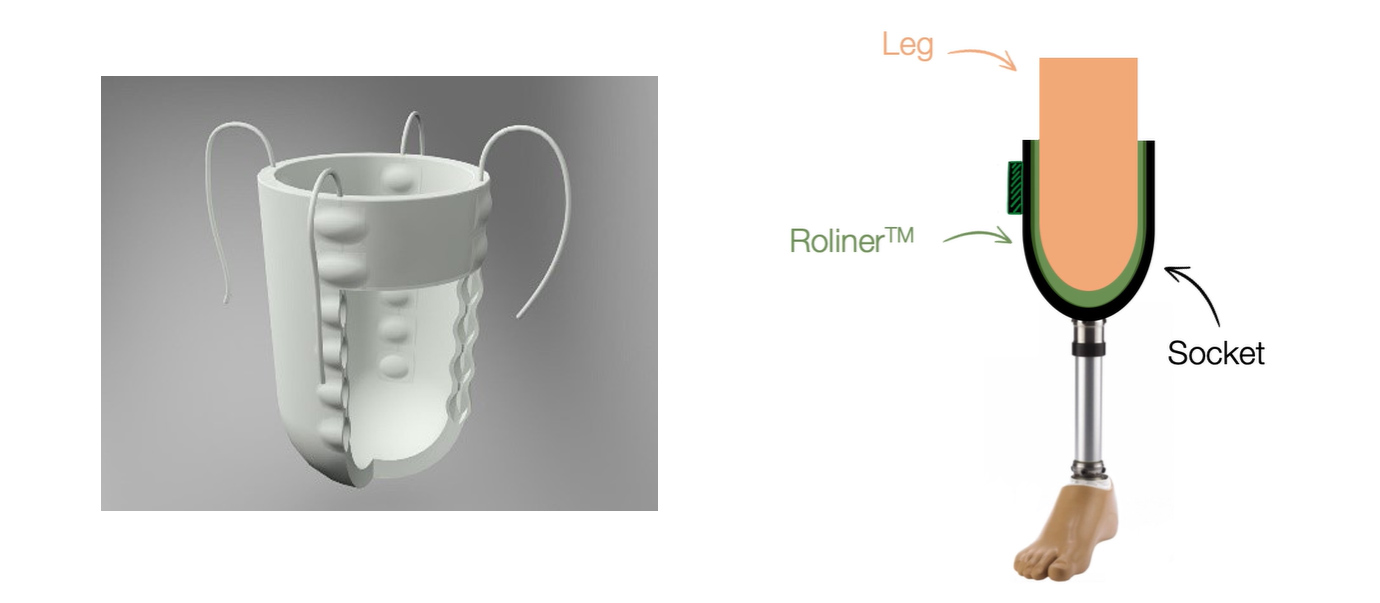AI controlled adaptive fitting device for prosthetics
Roliner has developed a self-adjusting wearable that helps ensure the comfort of people using a prosthetic device. The device fits between the wearer and their prosthetic, and uses artificial intelligence to adapt to a person’s changing body shape, reducing pain and preventing injury that can be caused by a hard prosthetic.
Origins
The human body changes shape, but prosthetic fittings cannot, because they are made of hard plastics to carry a body’s weight. This problem causes wounds, and leaves millions of amputees dependent on fitting clinics for the rest of their lives. With the goal of giving amputees comfort and confidence, Uğur Tanriverdi and Firat Güder decided to develop Roliner, a wearable device, that understands changes in an amputee’s stump and instantly adapts to them with AI.
Team
Team Roliner is a perfect combination of science, academia, and industry. It consists of academics and scientists specialised in biorobotics, machine-learning, medical device design and sensors, and also has business development experts, surgeons, clinicians and mentors in the medtech industry. Team Roliner has the experience, energy and the ambition to take this innovation forward and change the lives of millions.
The project
Roliner is an adaptive wearable device that combines the unique features of microfluidics, robotics and material science. An amputee places the device over their stump before putting on their prosthetic limb. When the user wears the prosthetic limb, Roliner starts adjusting itself to a comfort level that was determined by the user in the past. As the user walks and changes the settings via a mobile app, Roliner’s AI learns the best setting to automatically apply in the future to avoid pressure sores.

The solution enables individuals with prosthetics to:
- manage their prosthetics and give them more control over their condition;
- avoid chronic pressure ulcers, which can occur among amputees – especially diabetics;
- remain more active and productive by enjoying pain-free daily lives.
EIT Health has provided an invaluable network that supports the project’s business, clinical and technological activities at the same time. EIT Health also provides research funding, with an award of €612 000 in 2019. The project has already received £200 000 in research funds from MedTech SuperConnector (by Research England) in 2018, and will seek further funds in 2021 for scaling up for EU and international operations.
Impact
Patients will enjoy an improved quality of life thanks to a device that increases the comfort of their prosthetic and reduces injuries, so that they can stay more active. Healthcare services will save money due to reduced need for people wearing prosthetics to have them refit, or to undergo treatment for wounds. Society will benefit from reduced healthcare costs and greater productivity among people wearing prosthetics.
Why this is an EIT Health project
This project is in keeping with the EIT Health Focus Area of “Improving Care Pathways” because it uses cutting-edge technology to improve the health and quality of life of people who wear a prosthetic. It is also in keeping with the Focus Area of “Bringing Care Home” because the device automatically makes adjustments that once had to be made at a fitting clinic.
Roliner is the world’s first robotic interface that will work with all existing prosthetic limbs; turning them from a non-adaptive system into an adaptive robotic system. It will revolutionise the use of prosthetic limbs.
Ugur Tanriverdi, Roliner Lead Researcher
Partners

CLC/InnoStars: France
Partner classification: Business, Tech Transfer, Clusters, Other NGOs
Partner type: Associate Partner
Cap Digital is the French business hub for digital and ecological transformation and the biggest cluster in Europe. 1000 members including 830 startups / SMEs, 70 large companies, 70 academic, 12 VCs. Health / Well Being / Silver Economy as a target sector (150+ members). Education / Lifelong learning / HR as a target sector (150+ members). AR/VR/3D, IoT/Robotics, Big Data, AI as technologies (170+ members). Main actions: Energizing the ecosystem Accompanying experimentations Access to R&D public funding (regional, national, European) Providing intelligence Access to private funding Business Coaching International development
Key Activities in Business Creation
Business coaching, Testing & Validation
Key Activities in Education
Entrepreneurship training, training






CLC/InnoStars: InnoStars
Partner classification: Business, Education, Research
Partner type: Core Partner
GE Healthcare, as a leading provider of medical imaging, monitoring, biomanufacturing, and cell and gene therapy technologies, enables precision health in diagnostics, therapeutics and monitoring through intelligent devices, data analytics, applications and services. With over 100 years of experience in the healthcare industry and more than 50,000 employees globally, the company helps improve outcomes more efficiently for patients, healthcare providers, researchers and life sciences companies around the world.
GE Healthcare
Key Activities in Research and Developement
Other research, Biomedical engineering, Life Sciences, Clinical research
Key Activities in Corporate Innovation
Pharma, Med Tech, ICT, Diagnostics, Imaging
Key Activities in Business Creation
Incubation, Finance & Investment, Business coaching, Testing & Validation
Key Activities in Education
Business Schools, Entrepreneurship training, Healthcare professional education/training






CLC/InnoStars: UK-Ireland
Partner classification: Education, Research
Partner type: Core Partner
Imperial College London is a world leading, science-based university that develops the next generation of researchers, scientists and academics through collaboration across disciplines, harnessing science and innovation to tackle global challenges.
Imperial College London
Imperial College London, Exhibition Rd, London SW7, UK
Key Activities in Corporate Innovation
Med Tech, ICT
Key Activities in Social Innovation
Healthcare provision
Key Activities in Business Creation
Technology Transfer
Key Activities in Education
Business Schools, Entrepreneurship training, Technical faculties, Medical faculties, Healthcare professional education/training


